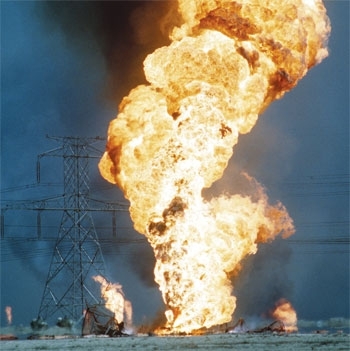Environmental Security (main)
From The Encyclopedia of Earth
Environmental Security
Environmental Security refers to the relationship between the environment and the many aspects of "security" in human societies. This includes:
- impacts of natural disasters such as earthquakes, storms, draughts, floods, landslides, or volcanic action on human populations;
- impacts of environmental changes caused on humans on large populations, such impacts of climate change, deforestation, or reduced soil productivity;
- military or violent conflict arising from environmental issues such as over access to water, or environmentally induced population movements;
- impacts on the environment caused by military conflict, such as the 1991 major oils spills and fires related to the first Gulf War;
- environmental impacts of security-related activities such as, dumping of munitions, and concerns about military uses sonar impacting whales; and,
- the impacts of changing environmental conditions on military operations and strategic issues, such as reduced ice coverage in the Arctic.
There is also some use of the term environmental security to refer to the security of the natural environmental "from" human damage in recognition on its inherent value.
========
-
 Featured Article
Featured Article  Mobility, Globalization, and Antimicrobial...This Perspective article written by Douglas W. MacPherson, Brian D. Gushulak, William B. Baine, Shukal Bala, Paul O. Gubbins, Paul Holtom, and Marisel Segarra-Newnham*, appeared... More »
Mobility, Globalization, and Antimicrobial...This Perspective article written by Douglas W. MacPherson, Brian D. Gushulak, William B. Baine, Shukal Bala, Paul O. Gubbins, Paul Holtom, and Marisel Segarra-Newnham*, appeared... More »
Recently Updated
 Environment and Security Last Updated on 2011-07-05 00:00:00 Environmental security refers to the protection of important ecosystem services and assurance of a supply of natural resources, including water, soil, energy, and minerals, in order to enable continued economic and social well being." TheExpandingDefinition of National Security This broader view of national security reflects the fact that new global pressures now threaten the well being and resilience of both human society and the natural environment. These pressures include population growth, increased demand for energy and materials, and competition for access to land, water, minerals, and other vital natural resources. The resulting impacts include changes in global climate and degradation of clean air and water, soil, forests, and wetlands, all of which have the potential to compromise energy security, food security, supply chain security, and other... More »
Environment and Security Last Updated on 2011-07-05 00:00:00 Environmental security refers to the protection of important ecosystem services and assurance of a supply of natural resources, including water, soil, energy, and minerals, in order to enable continued economic and social well being." TheExpandingDefinition of National Security This broader view of national security reflects the fact that new global pressures now threaten the well being and resilience of both human society and the natural environment. These pressures include population growth, increased demand for energy and materials, and competition for access to land, water, minerals, and other vital natural resources. The resulting impacts include changes in global climate and degradation of clean air and water, soil, forests, and wetlands, all of which have the potential to compromise energy security, food security, supply chain security, and other... More »  Environment & Security (Environmental Security) Last Updated on 2011-07-05 00:00:00 Environmental security refers to the protection of important ecosystem services and assurance of a supply of natural resources, including water, soil, energy, and minerals, in order to enable continued economic and social well being." TheExpandingDefinition of National Security This broader view of national security reflects the fact that new global pressures now threaten the well being and resilience of both human society and the natural environment. These pressures include population growth, increased demand for energy and materials, and competition for access to land, water, minerals, and other vital natural resources. The resulting impacts include changes in global climate and degradation of clean air and water, soil, forests, and wetlands, all of which have the potential to compromise energy security, food security, supply chain security, and other... More »
Environment & Security (Environmental Security) Last Updated on 2011-07-05 00:00:00 Environmental security refers to the protection of important ecosystem services and assurance of a supply of natural resources, including water, soil, energy, and minerals, in order to enable continued economic and social well being." TheExpandingDefinition of National Security This broader view of national security reflects the fact that new global pressures now threaten the well being and resilience of both human society and the natural environment. These pressures include population growth, increased demand for energy and materials, and competition for access to land, water, minerals, and other vital natural resources. The resulting impacts include changes in global climate and degradation of clean air and water, soil, forests, and wetlands, all of which have the potential to compromise energy security, food security, supply chain security, and other... More »  Mobility, Globalization, and Antimicrobial Drug Resistance Last Updated on 2011-01-19 00:00:00 This Perspective article written by Douglas W. MacPherson, Brian D. Gushulak, William B. Baine, Shukal Bala, Paul O. Gubbins, Paul Holtom, and Marisel Segarra-Newnham*, appeared first in Emerging Infectious Diseases—a peer-reviewed, open access journal published by the U.S. Centers for Disease Control and Prevention expressly to promote the recognition of new and reemerging infectious diseases around the world and improve the understanding of factors involved in disease emergence,/ prevention, and elimination. The article is a verbatim version of the original and is not available for edits or additions by Encyclopedia of Earth editors or authors. Companion articles on the same topic that are editable may exist within the Encyclopedia of ... More »
Mobility, Globalization, and Antimicrobial Drug Resistance Last Updated on 2011-01-19 00:00:00 This Perspective article written by Douglas W. MacPherson, Brian D. Gushulak, William B. Baine, Shukal Bala, Paul O. Gubbins, Paul Holtom, and Marisel Segarra-Newnham*, appeared first in Emerging Infectious Diseases—a peer-reviewed, open access journal published by the U.S. Centers for Disease Control and Prevention expressly to promote the recognition of new and reemerging infectious diseases around the world and improve the understanding of factors involved in disease emergence,/ prevention, and elimination. The article is a verbatim version of the original and is not available for edits or additions by Encyclopedia of Earth editors or authors. Companion articles on the same topic that are editable may exist within the Encyclopedia of ... More »  Emergency Planning & Community Right-to-Know Act, United States (Emergency Planning & Community Right-to-Know Act, United States) Last Updated on 2006-12-06 15:13:40 The Emergency Planning & Community Right-to-Know Act (EPCRA) provides a national framework for emergency planning related to the release of hazardous chemicals. The U.S. Environmental Protection Agency provides the national leadership. However, most of the actual work is carried out through State Emergy Response Commissions (SERCs) and local emergy planning committees (LEPCs) The Emergency Planning and Community Right-to-Know Act (EPCRA,codified at 42 U.S.C. 11001-11050) was enacted in 1986 as Title III of the Superfund Amendments and Reauthorization Act (P.L. 99-499). EPCRA established state commissions and local committees to develop and implement procedures for coping with releases of hazardous chemicals, and mandated annual reporting to government officials on environmental releases of such chemicals by the facilities that manufacture or use them in significant amounts. EPA... More »
Emergency Planning & Community Right-to-Know Act, United States (Emergency Planning & Community Right-to-Know Act, United States) Last Updated on 2006-12-06 15:13:40 The Emergency Planning & Community Right-to-Know Act (EPCRA) provides a national framework for emergency planning related to the release of hazardous chemicals. The U.S. Environmental Protection Agency provides the national leadership. However, most of the actual work is carried out through State Emergy Response Commissions (SERCs) and local emergy planning committees (LEPCs) The Emergency Planning and Community Right-to-Know Act (EPCRA,codified at 42 U.S.C. 11001-11050) was enacted in 1986 as Title III of the Superfund Amendments and Reauthorization Act (P.L. 99-499). EPCRA established state commissions and local committees to develop and implement procedures for coping with releases of hazardous chemicals, and mandated annual reporting to government officials on environmental releases of such chemicals by the facilities that manufacture or use them in significant amounts. EPA... More » 